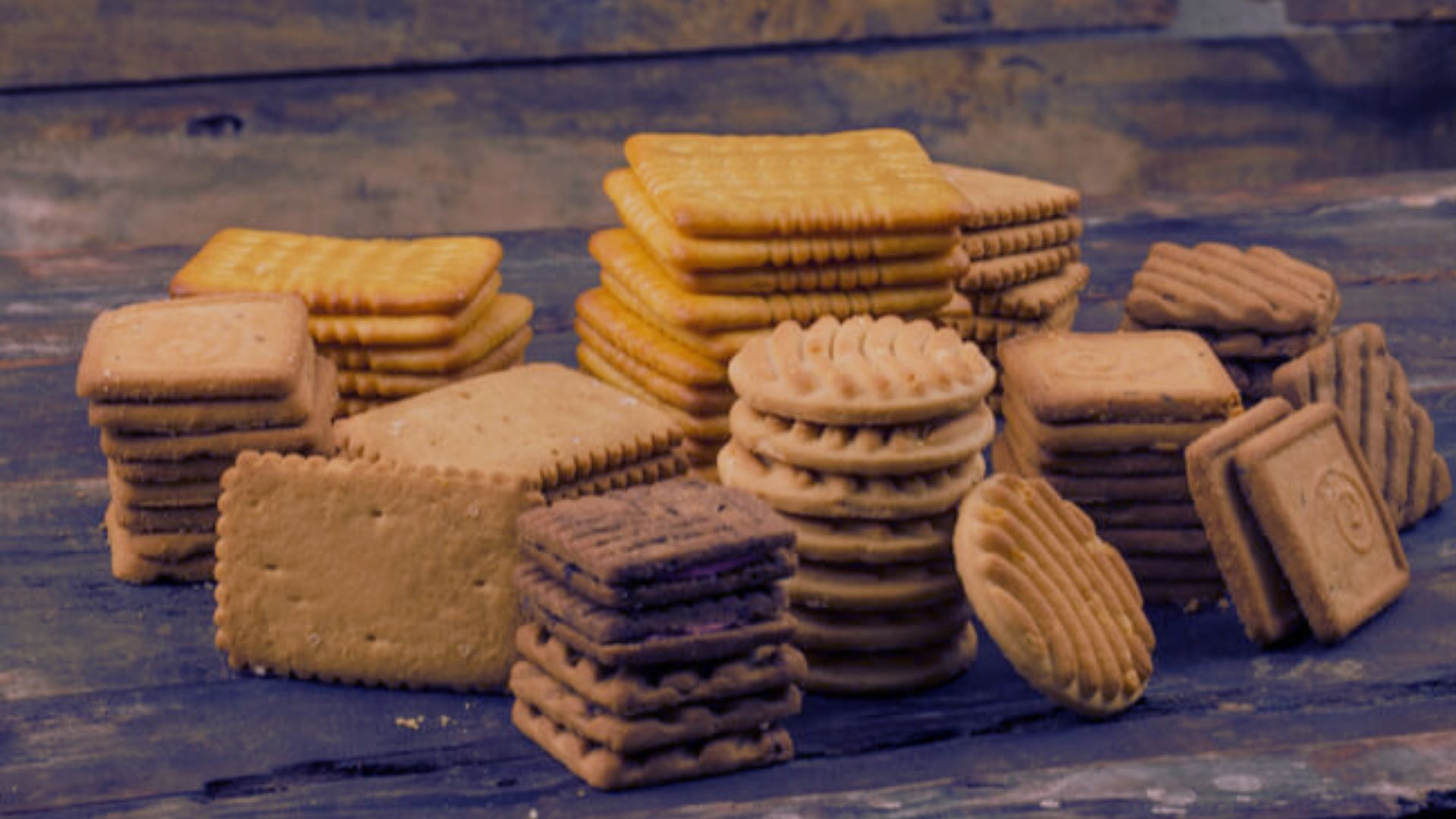Biscuits, those delectable delicacies adored in many countries, frequently have a magical touch. A great experience awaits those who like learning about different countries via their culinary traditions. Consider biscuits with unexpected ingredients such as bacon and chili—a daring departure from typical baking options. These unusual versions may pique your interest if you have an adventurous attitude and appreciate pushing the boundaries in your culinary endeavors.
Today, we’ll explore the charm of English biscuits, also known as “Biscuiți Englezești” to some. Despite their unassuming name, these biscuits possess a captivating history and an exquisite taste that has endured the test of time.
Let’s discover the world of English biscuits that not only delight our taste buds but also provide digestive benefits. From the timeless favorite, Digestive biscuit, to the buttery Shortbread, we will explore the most beloved English biscuits known for their digestion-friendly properties.
English Biscuits: A Tale of Tradition and Evolution
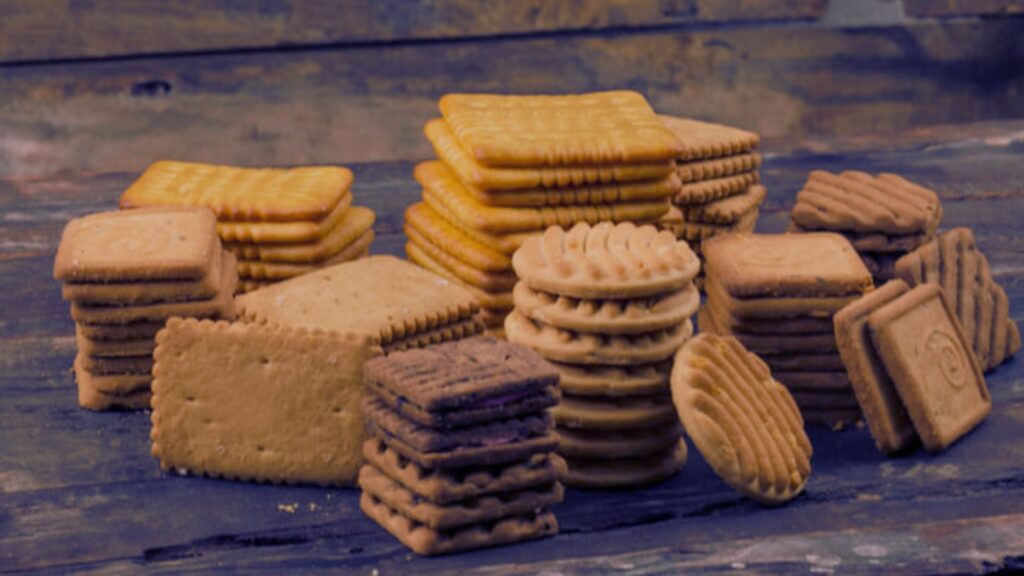
In the United States and certain parts of English Canada, the term “biscuit” has a specific definition. In these regions, a “biscuit” is a type of quick bread that is similar to a scone and is usually not sweet.
RephraseThese rolls are often known as “baking powder biscuits” or “buttermilk biscuits” when buttermilk is used. However, there is a regional variation in the South called “beaten biscuit,” and in New England, they are referred to as “sea biscuits.” These variations have a firmer texture compared to the softer dough of traditional biscuits, more closely resembling hardtack.
The word “biscuit”, when used in the English language, is used differently in two regions. This oddity can be traced back to English bread and yeast cookery author Elizabeth David’s writing. She sheds light on this difference in her work.
In ancient French times, the word we know today as “biscuit” was spelled as “biscuit”. Biscuit is derived from two Latin words: bis (twice) and conquer, cactus (to cook, cooked). Essentially it means twice-cooked. It’s exactly how it sounds. The original way of making biscuits was to cook them twice. First baked and then dried out slowly in a moderate oven. Over time this practice changed and during the 14th century, in middle England, the term was adapted into what we know today as biscuit.
This journey reflects on the rich history of cooking styles and continental traditions that were molded into one baking method. It shows us that language itself can give us an insight into how food has evolved over time.
The Evolution of the Biscuit: From England to Global Delight
Biscuits have a rich history that originated in England and have made their way around the world, delighting taste buds everywhere. In different countries, biscuits have experienced adaptations to incorporate unique local flavors. For instance, take the American “cookie,” which is closely related to the traditional biscuit but with a twist – it’s typically softer and chewier, catering to American taste preferences. But the story of biscuits extends beyond geographical boundaries.
Today, as people become more health-conscious, there has been a surge in innovation within the biscuit industry. Many brands now offer whole-grain, reduced-sugar, or gluten-free varieties of the traditional English biscuit to cater to health-conscious consumers. These adaptations align with current dietary trends and appeal to a wider audience seeking healthier options.
The original biscuit recipe has a certain timeless quality that makes it inimitable despite these contemporary changes. The original English biscuit continues to be unsurpassed by purists and traditional flavor enthusiasts. Its straightforward yet pleasant flavor never fails to bring back memories of the rich history and culinary heritage that these sweets bring to our meals.
The Most Popular British Biscuits
According to a recent survey, the traditional Chocolate Digestive biscuit is king of the delicious world of British biscuits. This well-liked biscuit has established itself as the top pick for biscuit lovers in the UK.
#1. Digestive Biscuits
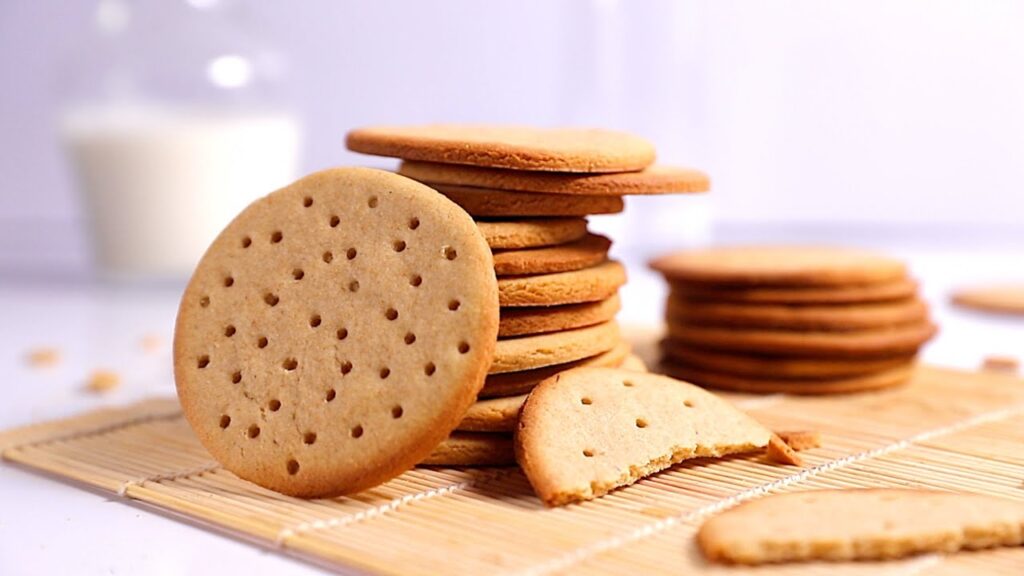
History and Origins:
The United Kingdom in the early 1800s saw the birth of digestive biscuits. Two Scottish doctors, Robert Smith and John Weir made them think they could aid digestion. The name came from that belief: “digestive”. They thought it had antacid properties because of the sodium bicarbonate they used.
It didn’t take long for people in the UK and British Empire to start loving these biscuits. They were usually enjoyed as a snack or dessert and even ended up being included in recipes for things like cheese platters or trifles.
Ingredients:
Digestive biscuits get their signature taste using core ingredients like wheat flour, whole wheat flour, sugar, palm oil, sodium bicarbonate, ammonium bicarbonate, water, salt, malic acid, and citric acid. Some brands may use eggs, milk, or malt extract to make them more flavorful or change their texture.
Health Benefits:
Digestive biscuits might offer several possible health advantages:
- Better Digestion: The fibre in these cookies is essential for keeping a healthy digestive tract. Fibre can assist in preventing constipation by keeping things flowing easily through the digestive system.
- Gut health: Some digestive biscuits may include live bacteria and probiotics that support gut health. Probiotics have been shown to improve immune function, improve digestion, and lower the risk of certain illnesses.
- Heart health: Whole wheat flour is a common ingredient in digestive biscuits. The consumption of whole grains, which are high in fibre and other heart-healthy nutrients, can improve cardiovascular health.
Digestionary biscuits’ sugar content might provide you a fast energy boost. If consumed in moderation, digestive biscuits can be a healthy snack choice.
#2. Rich Tea Biscuits

History and Origins:
Rich tea biscuits have a fascinating history dating back to the 18th century in Yorkshire. Originally marketed to the elite as an advantageous snack due to their wholesome grains and lower levels of sugar in comparison to other biscuits of the time, the biscuits garnered a broad following among various social classes. To this day, rich tea biscuits remain a cherished classic in the UK.
Ingredients:
In the creation of rich tea biscuits, the key components are flour, water, sugar, and fat. Along with these, certain brands may incorporate baking powder, salt, and diverse flavorings. As a customary practice, wheat flour is utilized for these biscuits, although oats or barley may also be implemented.
Health Benefits:
Rich tea biscuits offers several health advantages:
- High in Fibre: Dietary fibre, which is essential for supporting digestive health, is a notable source of rich tea cookies. Constipation and regular digestive motions are encouraged by fibre.
- Low in Sugar:Rich tea biscuits have a comparatively low sugar level when compared to many other biscuit variants. They are therefore a good option for persons who have diabetes or want to control their blood sugar levels.
- Heart-Healthy: Rich tea biscuits are a good choice for those with heart disease or high cholesterol because of their low saturated fat and cholesterol concentration.
- Vitamins and Minerals: Rich tea biscuits can help you meet your daily requirements for important vitamins and minerals including iron, magnesium, and potassium. These vitamins and minerals are essential for well-being and good health.
Rich tea biscuits are still processed foods, and they should be consumed in moderation.
#3. Hobnobs
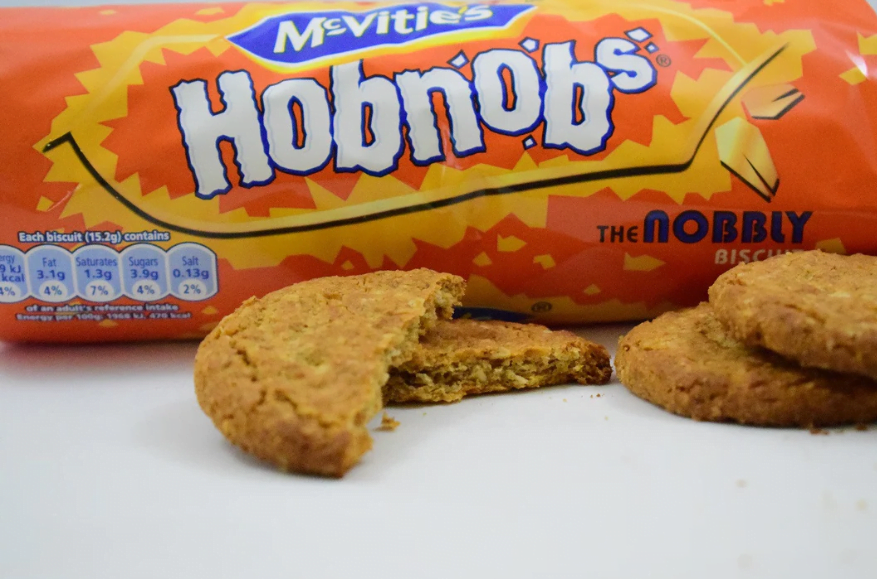
History and Origins:
As early as 1900, McVitie’s in the United Kingdom created Hobnobs, those delicious oaty biscuits. This biscuits are known for their distinctive, satisfyingly crunchy texture and savory, nutty flavor derived from oats. Hobnobs were initially promoted as a “working man’s biscuit” because of their low cost and high nutritious content, but they swiftly rose above socioeconomic strata to become one of the UK’s most adored biscuits.
Ingredients:
The main ingredients in Hobnobs include rolled oats and whole wheat flour, palm vegetable oil, sugar, partly inverted sugar syrup, raising agents (sodium bicarbonate and ammonium bicarbonate), and salt.
Health Benefits:
Hobnobs offer several potential health advantages:
- Digestive Health: Hobnobs are a noteworthy source of dietary fibre, which is essential for preserving a healthy digestive tract. Constipation can be avoided by promoting regular bowel motions thanks to fibre.
- Heart Health: By regulating blood sugar levels, the complex carbs in Hobnobs may lower the chance of developing heart disease.
- Weight management: Hobnobs might be a good option for people trying to control their weight or maintain a healthy weight because of its comparatively low fat and sugar content.
- Consistent Energy: Hobnobs’ complex carbohydrates give the body long-lasting energy, which is particularly advantageous for enhancing athletic performance and lowering weariness.
You may enjoy Hobnobs’ substantial flavor and texture while also supporting your health and wellness by integrating them appropriately into your diet.
#4. Shortbread
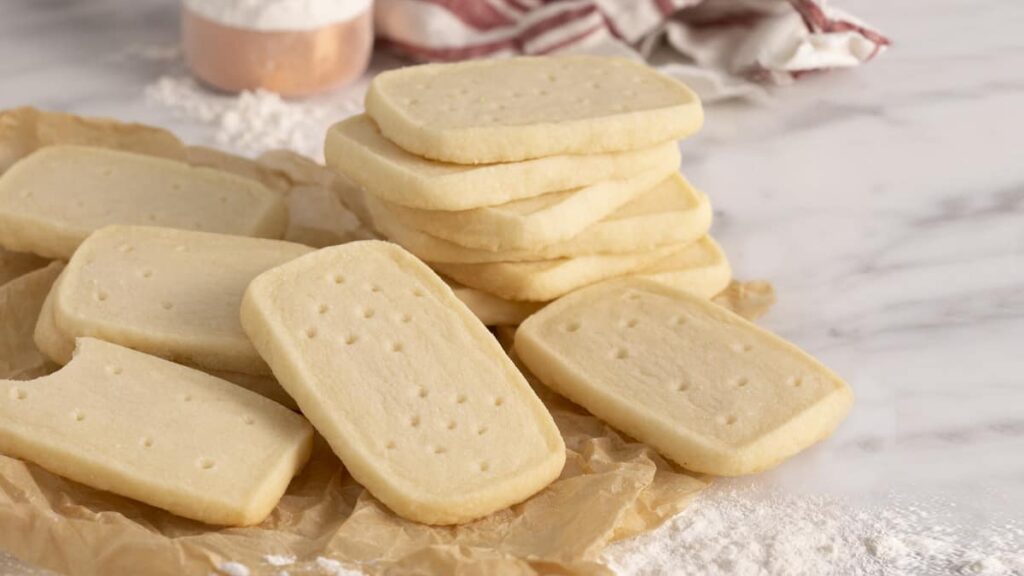
History and Origins:
Shortbread has a lengthy history, with roots dating back to 12th-century Scotland. While the exact beginnings are lost in the mists of time, the earliest identified biscuit recipe was published near the year 1736. This delectable dessert swiftly gained popularity among the Scottish nobility and became connected with special events, notably Hogmanay (New Year’s Eve).
Shortbread has now crossed boundaries and is loved all across the world. It’s a popular snack that goes well with tea or coffee. Furthermore, shortbread’s flexibility shows through in a variety of dessert dishes, including shortbread cookies, shortbread cakes, and shortbread trifles.
Ingredients:
Shortbread’s charm rests in its simplicity. It has three basic ingredients: butter, flour, and sugar. Shortbread’s richness and crumbly texture are mostly due to the comparatively high quantity of butter. To improve the flavor, certain recipes may use flavorings such as salt, vanilla extract, or other ingredients.
Health Benefits:
While shortbread isn’t typically considered a health food due to its high calorie and saturated fat content, it does offer certain nutrients:
- Carbohydrates and Protein: Shortbread contains carbohydrates and a bit of protein, which contributes to its satisfying nature.
- Calcium: It provides a modest amount of calcium, important for maintaining strong bones and teeth.
- Fiber: Shortbread contains some fiber, which can aid in digestion and promote a feeling of fullness.
It’s crucial to consume shortbread in moderation, especially for individuals with dietary restrictions or health concerns like high cholesterol.
#5. Ginger biscuits
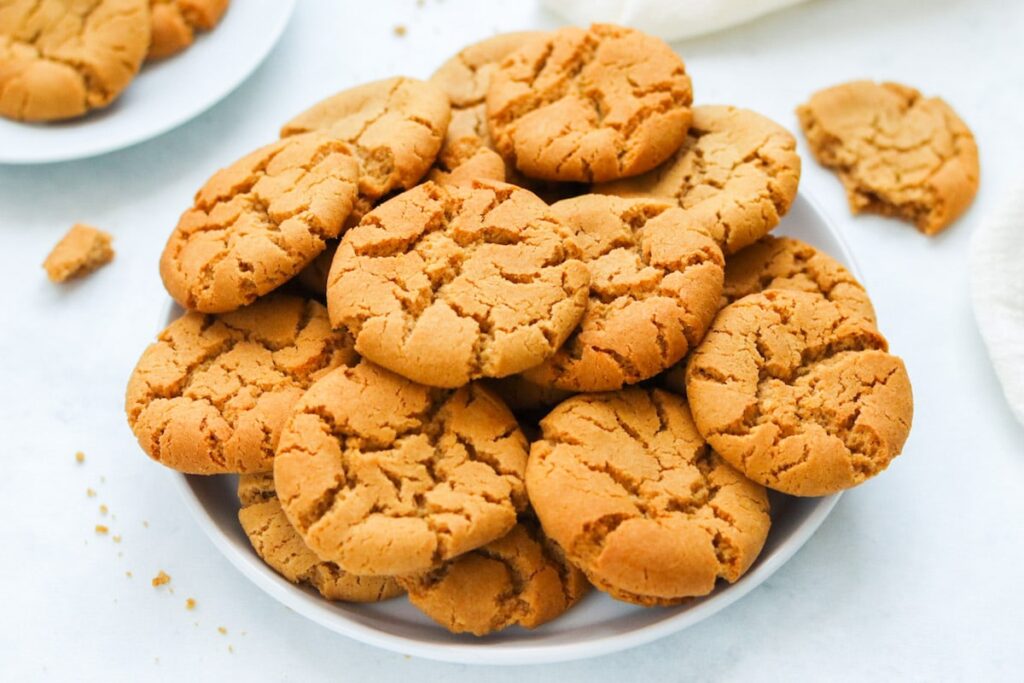
History and Origins:
British biscuits known as Ginger Nut Biscuits prominently use ginger as its main ingredient. It’s crucial to distinguish them from gingerbread since the former is noticeably crunchy while the latter is often smoother, softer, and more bread-like.
In the UK, Australia, New Zealand, the Isle of Man, and various parts of the British Empire, ginger biscuits are beloved as dunkable treats, commonly enjoyed with a cup of tea. Their history dates back to the 1840s, and they have been a staple in British biscuit culture. Huntley and Palmers, one of the most renowned British biscuit companies, commercially produced ginger nuts and ranked them as their best-selling biscuits from 1933 until the end of World War II.
Ingredients:
Ginger biscuits are typically made with flour, ginger, sugar, butter, eggs, and spices. For flavor and texture, some recipes may use ingredients such as molasses, baking soda, and salt.
Health Benefits:
Ginger biscuits can provide a variety of health advantages, especially if made with healthy grains and low-fat ingredients.
- Improved Digestion: Because ginger is believed to promote digestion, ginger cookies might be a stomach-friendly snack.
- Nausea Relief: Ginger has been shown to be excellent in alleviating nausea and vomiting, making these biscuits a relaxing option for stomach distress.
- Anti-Inflammatory characteristics: Ginger has anti-inflammatory characteristics that can benefit general health.
- Immune System Boost: Ginger can also help the body protect itself against infections by boosting the immune system.
In addition to the benefits of ginger, these biscuits can provide iron and fiber, essential for health and well-being.
#6. Bourbon Biscuit
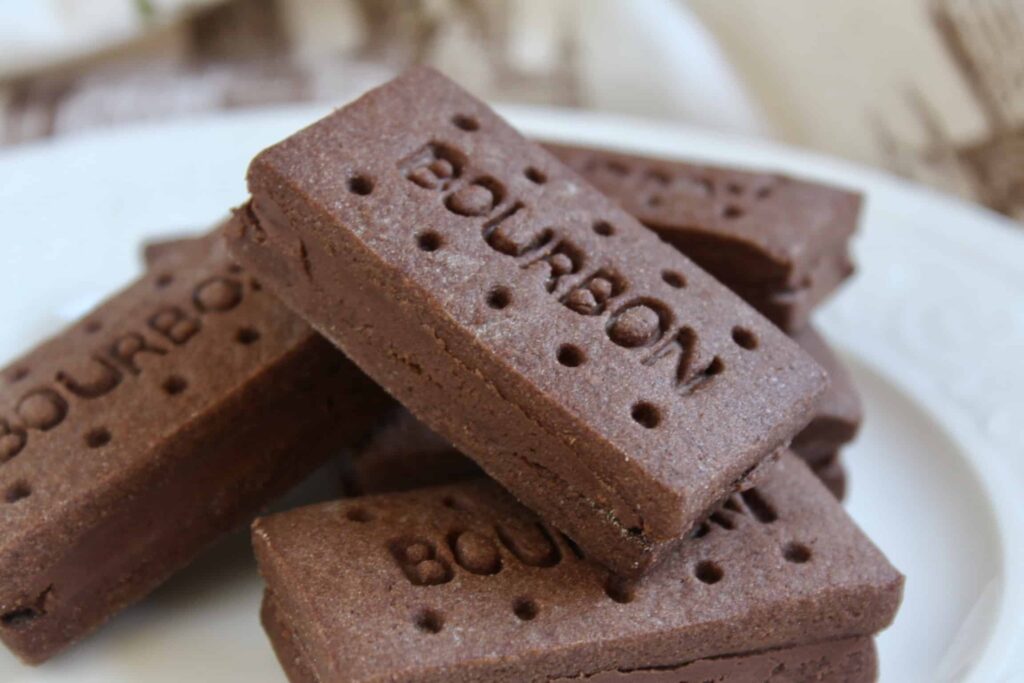
History and Origins:
The popular Bourbon biscuit was first produced in 1910 by the London-based Peek Freans biscuit firm. The Creola biscuit, as it was originally known, had a change in name to the Bourbon biscuit in 1912. In spite of the fact that this delicious delicacy was distinctively adorned with a chocolate cream filling.
The UK rapidly fell in love with Bourbon biscuits, which are now among the most popular biscuit varieties there. Other parts of the world, such as Australia, New Zealand, and India, are also drawn to them.
Ingredients:
Bourbon biscuits have a basic yet delectable ingredient list that comprises wheat flour, sugar, vegetable oil, chocolate powder, salt, raising agents, and emulsifiers. Sugar, cocoa powder, and milk powder are commonly used to make the decadent chocolate cream filling.
Health Benefits:
The following are some of the health advantages of eating Bourbon biscuits:
- Digestive Health: The fiber content of Bourbon cookies can help support good digestion and avoid constipation.
- Reduced Risk of Heart Disease: The fiber content of these cookies may help decrease cholesterol levels, thereby lowering the risk of heart disease.
- Increased Energy: Bourbon biscuits are high in carbs, which provide energy to the body.
- Mood Enhancement: Cocoa, which includes chemicals associated with increased mood, is used in the chocolate cream filling.
The key to enjoying their benefits while maintaining a healthy diet is to consume them in moderation.
#7. Nice Biscuits
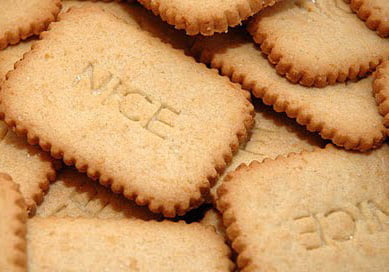
History and Origins:
The sound of “Nice” biscuits is simple. They are called after the city in southern France, and as such, they are pronounced the same as Nice, which is “neese.”
The origins of Nice biscuits are a topic of debate. Some believe they were named after the city of Nice in France, while others posit that they were simply labeled as “nice” because they were considered to be a delightful biscuit. Regardless of the naming origin, Nice Biscuits have a long history, with references dating back to 1895 when they appeared in an Army and Navy Co-operative Society price list. The English company Huntley and Palmers began producing Nice biscuits as early as 1904.
Ingredients:
Nice biscuits are often made using wheat flour, sugar, butter, eggs, baking powder, salt, and flavorings such as vanilla or lemon essence. To improve flavor and texture, certain recipes may use additional ingredients such as nuts, seeds, or dried fruit.
Health Benefits:
Nice biscuits can offer some potential health benefits, particularly when made with whole wheat flour and minimal sugar and fat:
- Digestive Health: Nice biscuits are a good source of fiber, which promotes a healthy digestive system.
- Probiotics: Some Nice biscuits may contain probiotics, beneficial bacteria that support gut health, aid digestion, boost the immune system, and reduce inflammation.
However, it’s essential to be mindful of their calorie and sugar content and consume Nice biscuits in moderation, as with any treat.
The Art and Science of Biscuit Dunking
Dunking biscuits is an art, and each type of biscuit has its unique dunking technique. Here’s a guide for two common biscuit types:
Regular Biscuit (Digestive, Butter Crackers):
- Dunk half the biscuit into your beverage of choice.
- Suck or eat the dunked section.
- Dunk half of the remaining piece (a quarter of the original biscuit), and eat that.
- Dunk the final triangle of the biscuit, while pinching one corner.
Chocolate-Covered Biscuit:
- Dunk half the biscuit.
- Lick off the chocolate at each stage.
- Finally, enjoy the biscuit underneath.
Choose Your Dunking Partner: A Warm Cup of Your Tea
With a delightful array of 13 types of biscuits to choose from, any hot drink will make an ideal dunking companion. The taste is always irresistible.
Remember Childhood Memories: Cookies and Milk:
Recapture the cherished moments of carefree childhood with a classic combination. Milk pairs beautifully with classic chocolate biscuits, but it may not be the best fit for biscuits with lemon and lime or those containing poppy seeds.
Like Them with Your Espresso?
For many, a morning without coffee is unthinkable. Coffee and biscuits make an iconic pair. While movies often depict people enjoying doughnuts or bagels with coffee, there’s something special about a good old biscuit dunked in a hot cup of black coffee. Breakfast biscuits are becoming increasingly popular and are a delightful way to introduce a touch of chocolate to your morning routine.
Biscuits Today: A Global Delight
English Biscuit (Biscuiţi Englezești), previously limited to the borders of England, has now become a global sensation, with retailers from Tokyo to Buenos Aires displaying it. International companies have expertly blended classic English recipes with local flavors, resulting in a delicious explosion of biscuit types to suit a wide range of tastes.
While the English biscuit has been around for generations, its popularity is on the rise. With continual developments in flavors and nutritional alternatives, the future looks even brighter. Vegan biscuits, organic options, and more unusual flavor combinations are on the increase. These modifications not only honour the biscuit’s history but also maintain it current in a world where culinary tastes are always changing.
The journey of English Biscuits, from ancient ovens to modern-day gourmet bakeries, serves as a testament to their enduring appeal. These biscuits are more than just a snack; they are a symbol of comfort, a slice of history, and a constantly evolving culinary art. Whether savored with a cup of tea on a rainy English afternoon or enjoyed as a midnight snack in a bustling city on the other side of the world, the English biscuit remains a cherished treat that transcends borders and brings joy to people worldwide.
Indulge in the Selection, One Biscuit at a Time
Choosing just one from this delectable array might seem like an impossible task. But, fear not, for there’s a delightful solution—enjoy them all, savoring each biscuit one at a time (though, not in a single sitting, of course).
While it’s entirely possible to maintain a healthy lifestyle while relishing biscuits, it’s the art of balance that reigns supreme, much like the harmony in life itself. We trust that our exploration of the most renowned British biscuits has brought something new to your world—perhaps akin to a lunar landing, but with biscuits instead of moon dust.
Conclusion:
In the world of biscuits, there’s an adventure awaiting every palate. The evolution of these delectable treats has taken them from their English homeland to international kitchens, where they adapt to local flavors. With health-conscious options emerging, the classic English biscuit remains an unbeatable delight for purists.
In the age-old tradition of English biscuits (Biscuiți Englezești), the term “biscuit” itself has traveled through time, shaped by language and history. Yet, the enduring popularity of these sweet wonders knows no bounds.
Among the beloved classics, the Chocolate Digestive reigns supreme, offering a delightful dunking experience. Preferences in biscuit choices may vary, but the joy of savoring these treats remains universal. Just remember to balance your indulgence, like all things in life.
So, whether you find comfort in a cozy cup of tea and Digestive biscuits, embark on a flavorful journey with ginger biscuits, or savor the rich history of Bourbon biscuits, there’s a biscuit for every moment and every mood. Embrace the joy of choice and the pleasure of savoring each one, one delicious bite at a time.

